The Village at Grand Traverse Commons Tour with Ray Minervini
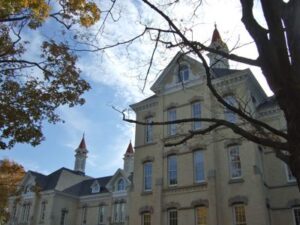
Did you know…the entire campus at the old Traverse City State Hospital—one million square feet of brick, wood and stone— was built from the ground up in less than 2 years? There are 400,000 square feet of space in Building 50 alone! That’s an architectural feat that must have taken an army. And that’s just one of the amazing facts I learned from Ray Minervini, developer of The Village at Grand Traverse Commons, on my recent behind-the-scenes tour.
When I was in high school, here in Traverse City, the old State Hospital was shut down and abandoned. The grounds became a destination for vandals and daredevils who returned with stories of ghosts, eerie tunnels and mysterious bumps in the night. It was sad to see such a huge piece of Traverse City history disappearing into the landscape as new developments surrounded it on all sides. Most of us just drove past the big stone pyramid on Division Street and barely wondered about the towering structures that lie dormant behind the tall pines.
And then came Ray Minervini. He had a vision of a thriving community, reminiscent of European cities where people worked, ate, entertained and lived together in the presence of history. Now, the site that was built in 1885 to house the mentally insane has begun a transformation into this vibrant hub of arts and culture, just as Ray imagined.
Other than a few cups of coffee at Cuppa Joe and special dinners at Stella, I hadn’t spent much time on the new Village campus until I met Bryan Ulbrich of Left Foot Charley when they became a Mealtickets client in 2007. He had begun transforming the old laundry facility into the winery and tasting room for Left Foot Charley. The image that stands out in my mind was a 2′ heaping pile of faucet handles leftover from the mazes of underground plumbing they removed during reconstruction. It was this salvation of the old, amidst plans for something new, that piqued my curiosity.
Which brings me to my recent tour with Ray. Beaming at the success of the Traverse City Wine Festival this summer on the grounds in front of Building 50, I asked Ray Minervini if he would take me on a behind-the-scenes tour this fall. “We’ll work our way from the bottom to the top,” he promised. I was determined to make sure he kept his word, and did he ever.
From the Bottom
The Village at Grand Traverse Commons is a 500-acre site located in the heart of Traverse City. That’s right, 500 acres, over 400 of which are parkland. Ray likes to call it “Traverse City’s Central Park.” The former asylum campus occupies 60 acres. And Building 50, the central building with the red spires is over 400,000 square feet. Ray and I began the tour at the bottom, in what’s called the Mercato of Building 50.
Just below ground level on the south side of Building 50 lies the Mercato. At one end is Stella, a fabulous Italian restaurant and one of the first tenants of The Village. I met Ray outside the elevators at the far end of the building. Just around the corner from Stella, as we entered the Mercato, I noticed there’s a small gallery exhibiting before & after images of the redeveloped spaces as well as artifacts discovered during renovation. It’s a great place to stop and appreciate all the work they’ve done so far.
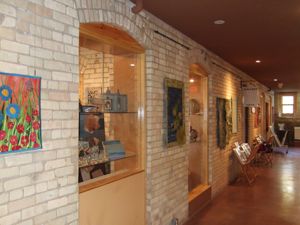
The Mercato is the main shopping venue at The Village, with everything from art and fashion to wine and gelato. The long hallway opens up on each side with arched open doorways leading into each space. Vendors goods extend out into the hallway, which is lined with an ever changing exhibition of art. Unlocking a non-descript door in the Mercato, Ray revealed a narrow steep staircase leading to the underground tunnel system.
I have to admit, I was a little leery of the tunnels. My great-aunt worked in the asylum for a short time, and one of her jobs was the transportation of patients in and out of the buildings by way of the tunnels. Her descriptions left me in no hurry to visit such a place. But times have changed, and so has The Village. So I ventured in. Lit from beginning to end with only small blubs overhead was a long tunnel constructed in hand-laid brick. The roof 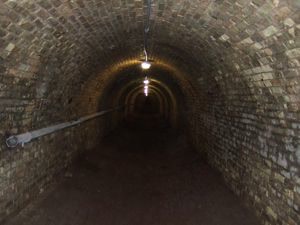 was arched, and the floor bowed in the center. It felt like looking down the barrel of a gun, only we were standing in it.
was arched, and the floor bowed in the center. It felt like looking down the barrel of a gun, only we were standing in it.
As we walked toward the mid-point of the tunnel, Ray explained how they would have built the space by slowly moving a wooden arch form, laying bricks on top to create the dome, and then sliding the form a few feet forward to continue the tunnel.
Up ahead, we could see a more recent addition to the roof, an iron covering, indicating we were directly underneath the parking area for the Mercato. As development continues, Ray imagines taking advantage of unique spaces like this, perhaps for private wine cellars.
Upon returning to land level, back the way we came, we proceeded straight to the top.
To the Top
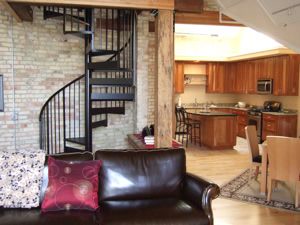 The south wing of Building 50, where reconstruction is nearly complete, was originally the Men’s residence. The first and second floors now house offices, including those of the developer, The Minervini Group. The third floor is largely residential, offering beautiful condos with open loft-style spaces. The renovation of these areas was often the most difficult as they had to meet the requirements of several agencies, including the National Trust for Historic Building, State regulations and National Park Service guidelines. The respect for historic craftsmanship is evident in every detail, from the polished wooden floors to the top of the 13′ plaster walls. For a look inside, our next stop was Ray’s condo in the restored attic.
The south wing of Building 50, where reconstruction is nearly complete, was originally the Men’s residence. The first and second floors now house offices, including those of the developer, The Minervini Group. The third floor is largely residential, offering beautiful condos with open loft-style spaces. The renovation of these areas was often the most difficult as they had to meet the requirements of several agencies, including the National Trust for Historic Building, State regulations and National Park Service guidelines. The respect for historic craftsmanship is evident in every detail, from the polished wooden floors to the top of the 13′ plaster walls. For a look inside, our next stop was Ray’s condo in the restored attic.
The attic space was not utilized as living or working space in the original design. But the Minervini Group decided it would make a great place for condos. And the view would be spectacular. The beauty of living inside the Village is this amazing juxtaposition of old and new. Butter yellow bricks and telltale high ceilings remind you it’s The Village, but otherwise, you might think it’s a loft in New York. Around the corner from the entrance, an iron staircase spirals up to the small loft bedroom. But we came to see lies higher yet.
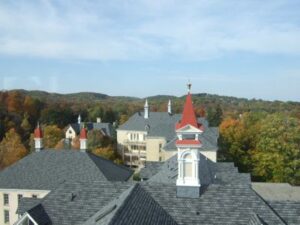
Looking up from the stairway landing, Ray pulled down a latch and released a small wooden ladder. After the trip into the tunnel, I realized I was wearing the wrong shoes for this tour. Sneakers would have been the way to go. And at the sight of this ladder with 2-inch rungs, I was going to have to be careful. Did I mention heights are not my favorite thing? So up we went. One at a time, up short ladders, holding pipes and wooden ledges, zigzagging our way up several small flights until we reached another latch. The roof.
We made it to the top. At last, we were inside one of the red spires that are synonymous with The Village. Even with the latched closed, the space was small, probably 5 feet wide at most. But the view was amazing. This is what I came for. We could see the colors of autumn in every direction, and with clear blue skies, it was easy to make out the view of west Grand Traverse Bay to the north and the Great Wolf Lodge and East Junior High to the south. Other than the top of the water tower, this is the highest view in The Village.
From South to North
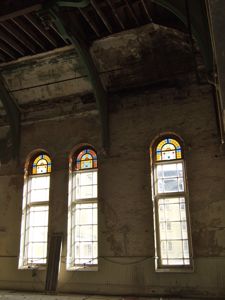
After safely managing my way back down the ladder, Ray offered to continue the tour on the North side of the building,so I could see the areas not yet restored. We wandered through the Mercato once again, past Sweet Asylum and “the best gelato this side of Italy,” according to my guide. If you’ve ever wondered what lies behind those heavy metal doors displaying Employees Only signs, this is where your tour begins.
The large central area in the middle of Building 50 is the Chapel. There are several huge spaces, one leading into the next, with towering brick walls brightened by natural light spilling in from 8′ windows. Here, Ray envisions a grand restaurant. I love turning my camera to macro mode to capture the details and textures all around me. So many modern restaurants like Olive Garden try to recreate this atmosphere, but it’s not the same. Here, the history is real. Ray agreed, “When you look at it, it has the patina of age that you just can’t create.”
Through more hallways and passages, in which I’d surely be lost without a guide, we ended up in the chapel itself. Thiswill be the gathering space for the Commons. The perfect place for wedding receptions, dances, and a host of community events. Closing my eyes, it’s easy to imagine music and laughter spilling from the windows while the neighboring condo units are barely disturbed—thanks to solid brick walls 2 feet thick to buffer the sound. After seeing the transformation of Stella and Left Foot Charley, it’s not so difficult to picture how beautiful this too will be.
As we wandered through more twists and turns along peeling lead paint and plaster walls, I picked up a few more interesting facts. The State Hospital once housed over 3500 patients. The philosophy used to treat their mental health was that of Thomas Story Kirkbride. He believed the road to mental health was surrounded by beautiful architecture, immersed in nature and grounded with hard work.
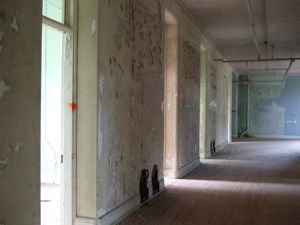
We made it to the long hallway of the women’s dormitory, and I realized it looked familiar. In fact, the north and south wings of Building 50 are built in an exact mirror image. But what’s really amazing is to realize these were built before computers and laser levels, scaffolding and even electricity…and yet the length of the hallways in both buildings are a perfect match, down to the micrometer.
Speaking of electricity, here’s another fascinating tidbit I picked up on the tour. Did you know the State Hospital was the first state-owned building with electricity? An on-site steam generator produced heat and electricity for the entire campus. In fact, they had electricity 20 years before the rest of Traverse City!
The Village, by the Numbers
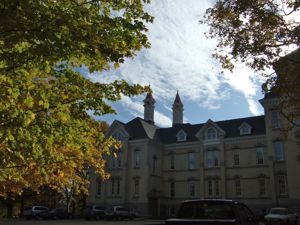
Back at street level, we exited Building 50 into the parking lot to take in the perfect autumn day. As we looked across Cottageview Drive, Ray explained more of the history of the other buildings on campus. Directly across from Building 50 is Pleasanton Bakery, formerly the fire station. I mentioned earlier, that Left Foot Charley and Higher Grounds occupy the former laundry facility. And next door to them, along Red Drive, is Underground Cheesecake in the old potato peeling building. That’s right, the hospital needed an entire building just for removing potato skins. With 3500 patients and countless staff, I guess that makes sense. There was also a butcher and a slaughterhouse on-site, but not on my tour, thanks.
I’m not great with numbers, but I am amazed by some of the statistics associated with constructing Building 50, the main administration building. Forgive me for all the zeros, but you have to admit this is impressive.
- 11,000,000 bricks, made locally in neighboring Grelickville
- 1,800 windows, many of which are over 8′ tall
- 400,000 sq. ft. in the main building alone
- With 1,000,000 sq. ft. of redevelopment space in the entire project, of which 250,000 sq. ft. are already complete, I asked Ray how he manages to tackle one of the largest historic redevelopment projects in the United States. “One little bite at a time,” he said with a smile.
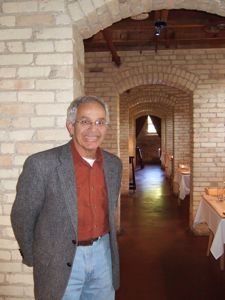
We ended our tour that day with a quick photo of the developer in one of his favorite spots, inside Stella. But before I left, I had one last question for Ray. There are so many rumors about ghosts from the old asylum, so I wondered if Ray had seen anything unusual. “Not once,” he said, almost as surprised as I was to hear it. He did have a great story about Genevieve, the ghost at Bowers Harbor Inn…but that’s a tale for another time.
For more information about The Village, visit their website at www.thevillagetc.com.
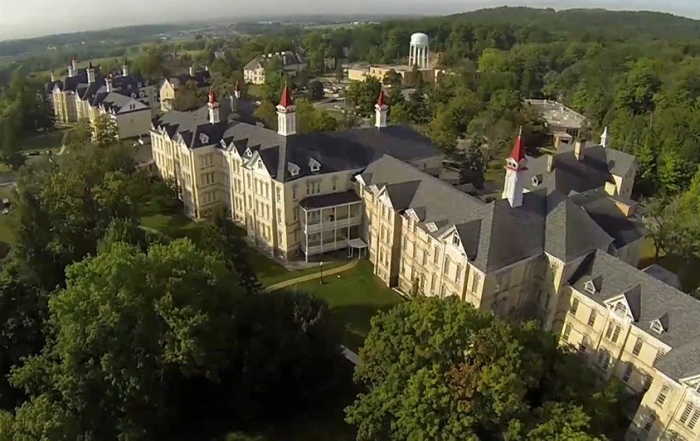



















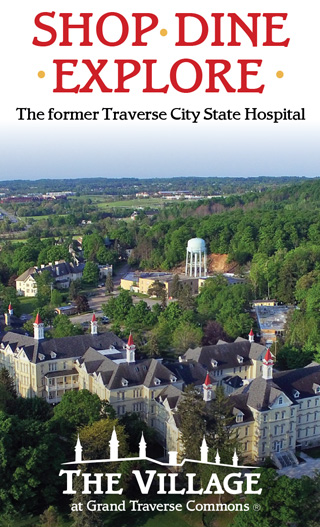


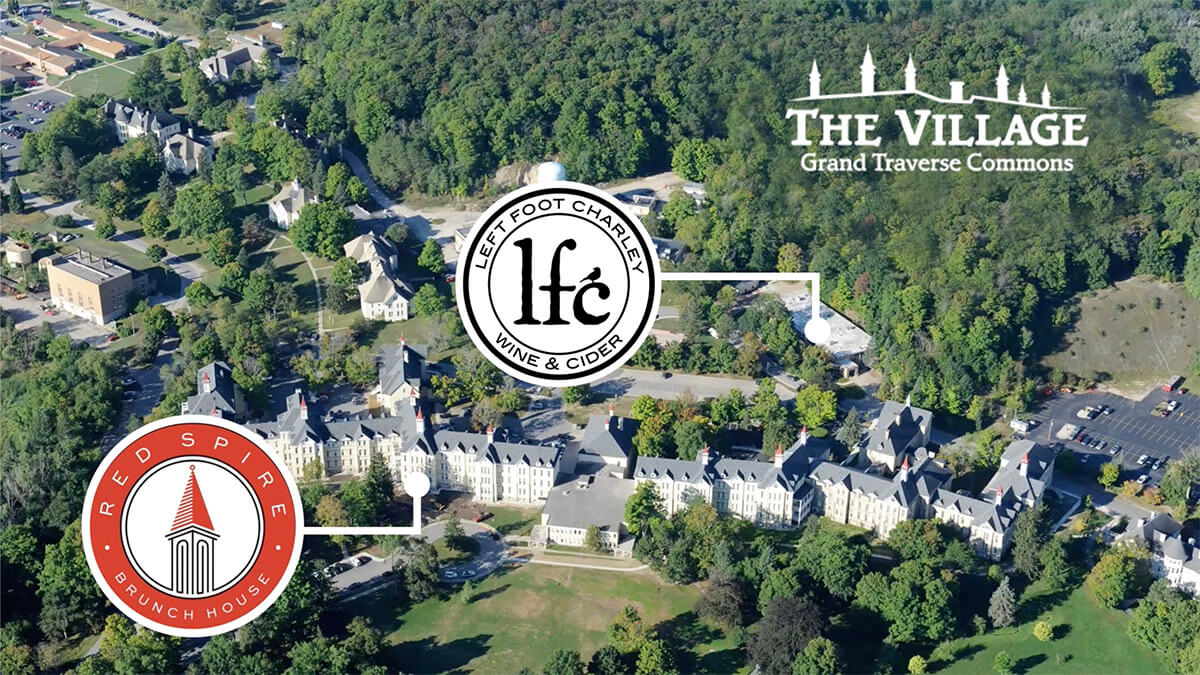

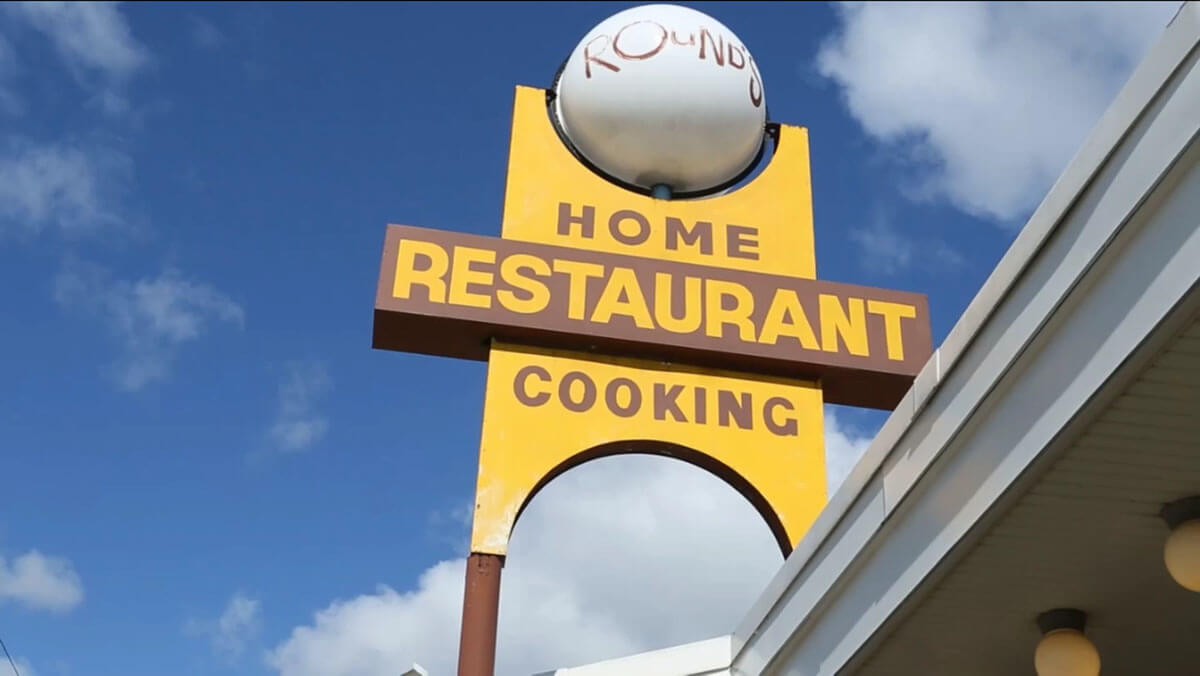
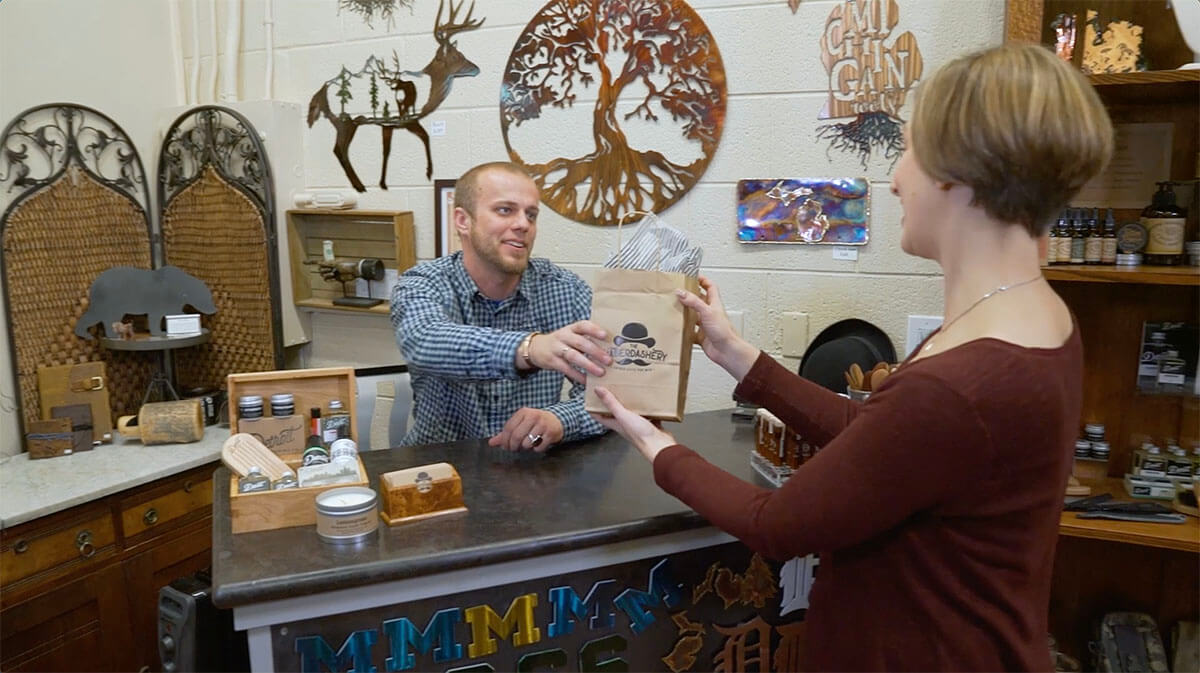
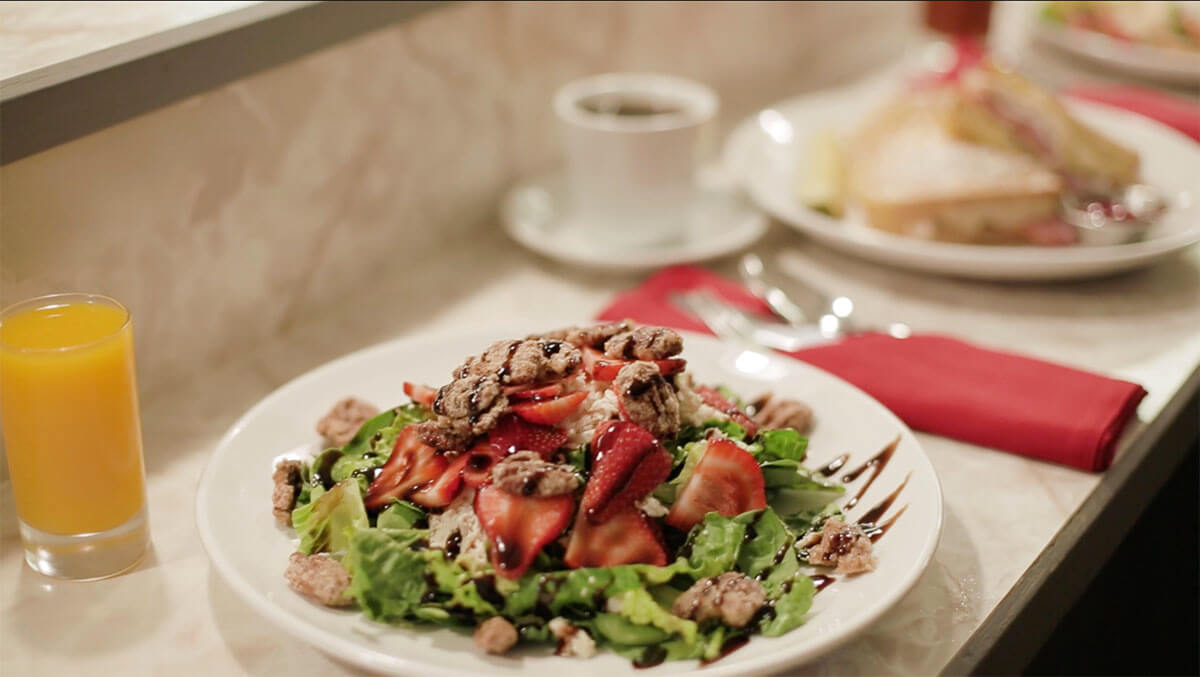




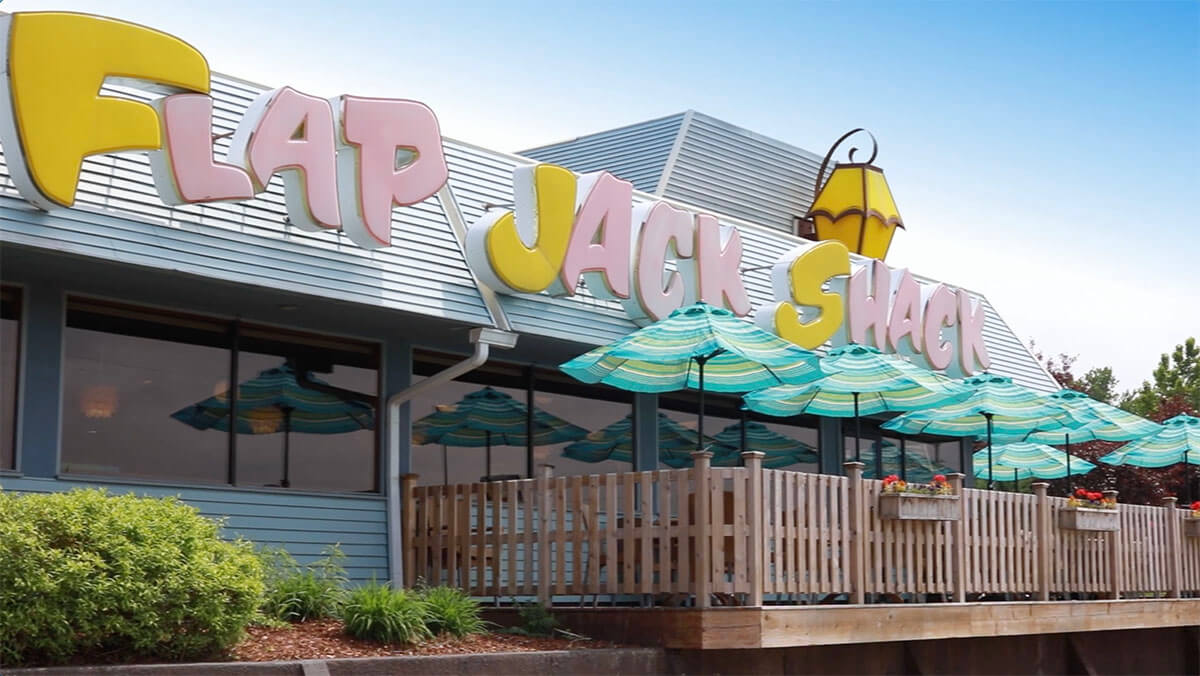
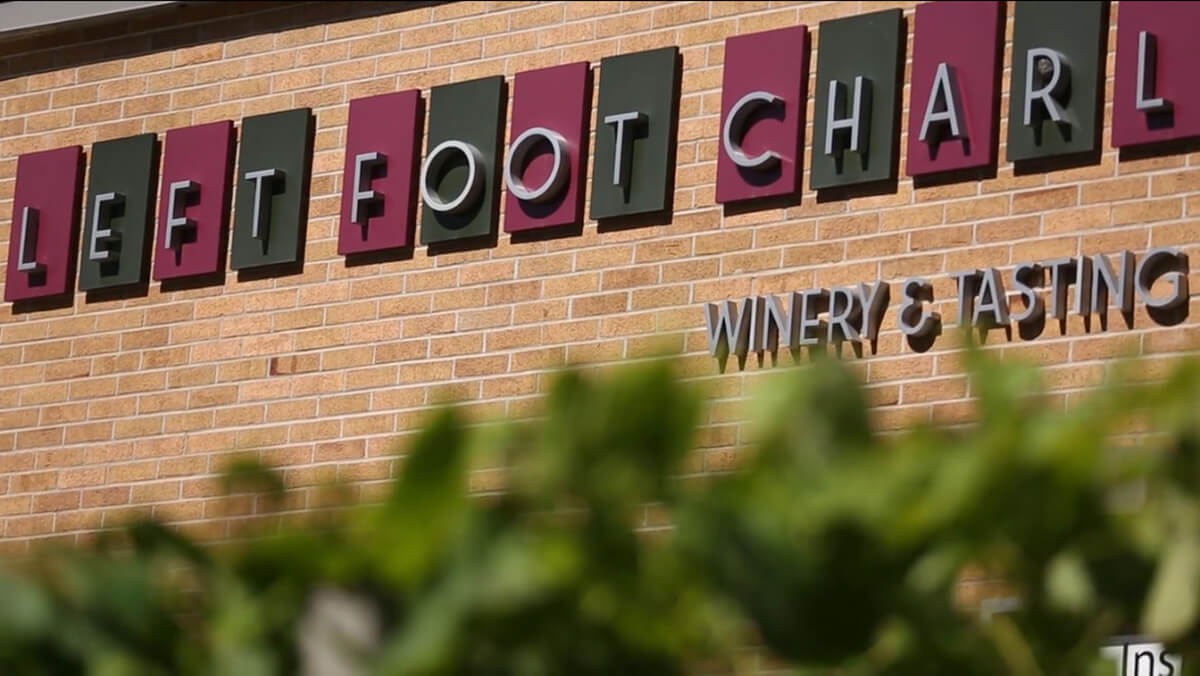





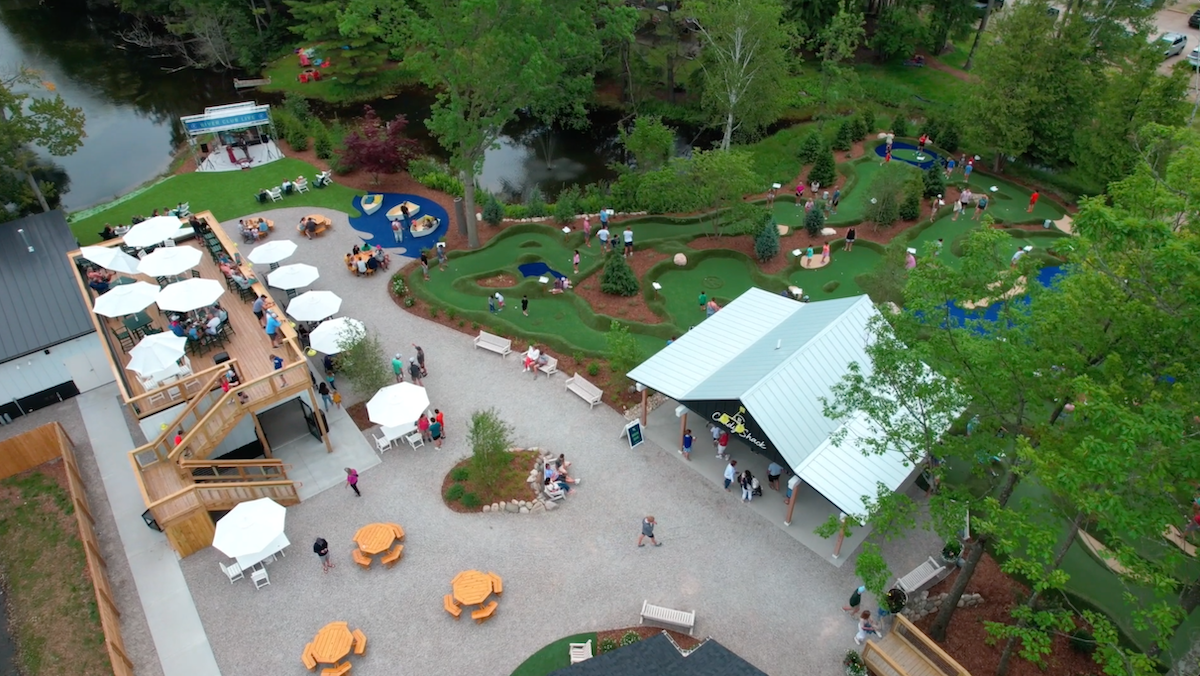
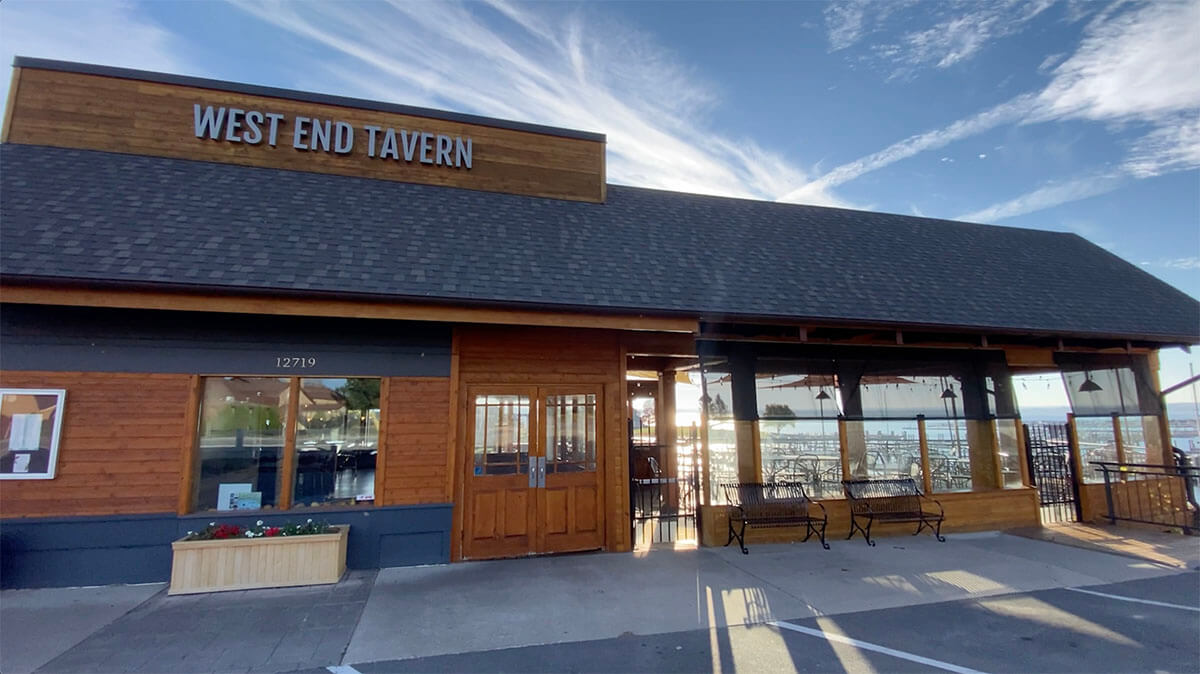


Get Social